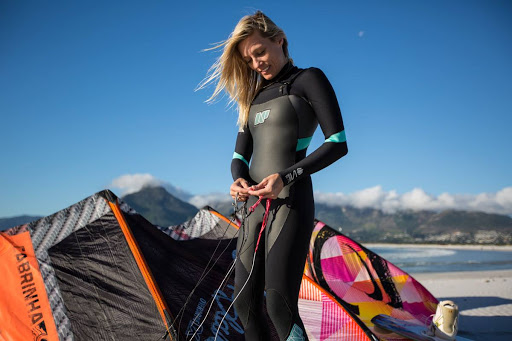If, like me, you live in a place with a pretty cold climate, a decent wetsuit will make the difference between kitesurfing year round or being a “fair weather” kiter! But what makes a good wetsuit for kitesurfing?
The great news is that wetsuit design has come a long way since I started out on my watersports addiction back in the 1980s. And you can now truly kite all year round safely and comfortably if you invest in the right wetsuit.
And thankfully you can now buy the best wetsuits for kitesurfing without breaking the bank.
So let’s dive in with a guide to what to wear, and when.
Wetsuit vs Drysuit?
This is a question I’ve toyed with myself recently, as we head into the British winter.
Firstly, to cover the differences, a drysuit is like a waterproof oversuit that you wear with some kind of undergarment such as thermal leggings and top.
They have neoprene seals at neck, cuffs and ankles (unless they have built-in 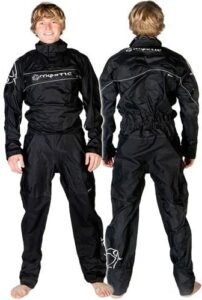 socks) to stop any water getting in.
socks) to stop any water getting in.
Drysuits tend to be loose fitting to allow for the use of undergarments.
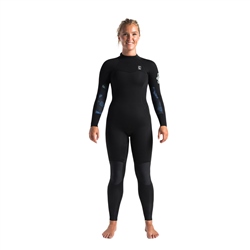 A wetsuit on the other hand is tight-fitting and keeps you warm by placing a layer of neoprene next to your skin to act as insulation against cold water and air. Very much like having a second skin.
A wetsuit on the other hand is tight-fitting and keeps you warm by placing a layer of neoprene next to your skin to act as insulation against cold water and air. Very much like having a second skin.
Although a good wetsuit, particularly a winter one, will keep almost all the water out, you do get a bit of water in through the neck and maybe the seams.
But the theory is that this water is trapped in the suit and warms up to create extra insulation from the cold.
I have to admit, I’ve never used a drysuit for kitesurfing although I was issued with one years ago for a sailing event and wore that for a couple of days.
I’ve got buddies who use both and have asked them for their views. And they’re pretty mixed, so I’ll just let you know my thoughts based on what they tell me and from the many reviews I’ve read.
There are two main benefits of a drysuit as I see it:
1. You can wear as many or few layers of thermal undergarments as you want or need, so should always be toasty, even in the coldest conditions.
2. You can take it off between sessions and not have to worry about climbing back into a cold wetsuit when you go back out on the water.
3. They tend to be warmer when you’re standing about on a windy beach.
The main disadvantages are:
1. They’re baggy and make swimming difficult.
2. If you do get water in through one of the seals, then it can be pretty miserable.
3. A decent one will cost you about twice the price of a decent winter wetsuit.
So my conclusion was that I’d rather have two good winter wetsuits than one drysuit. And, with the addition of a neoprene hoody, the issue of wind-chill on the beach is covered.
And to be honest, a decent winter wetsuit will let very little water in anyway. A few are now lined with quick-drying material, so the miserable experience of pulling a soggy, cold wetsuit back on is not as likely as it used to be.
So I’m sticking with wetsuits.
So What Makes a Great Wetsuit for Kitesurfing?
Well I personally think it comes down to 4 things:
- Comfort
- Warmth
- Durability
- Price
But of course there are a lot of features that come together to make the best wetsuit for a given price-range, so let’s look at some of the terminology and what it means:
Wetsuit Jargon
I won’t go into the “branding” names that each wetsuit manufacturer gives to its various features, although I’ll cover these in my reviews of the wetsuits I’m recommending.
But there are some basic things you need to know about:
Thickness – Wetsuits come in a range of neoprene thicknesses and typically a suit will be made up of two or three thicknesses of material.
The thicker material covers the main torso with the thinner stuff on the arms and legs, where flexibility is more important. And the thickness is always in mm.
So a warm weather wetsuit might be a 3/2, a mid-season suit 4/3 and a cold weather suit a 5/4, 5/3, or 6/4.
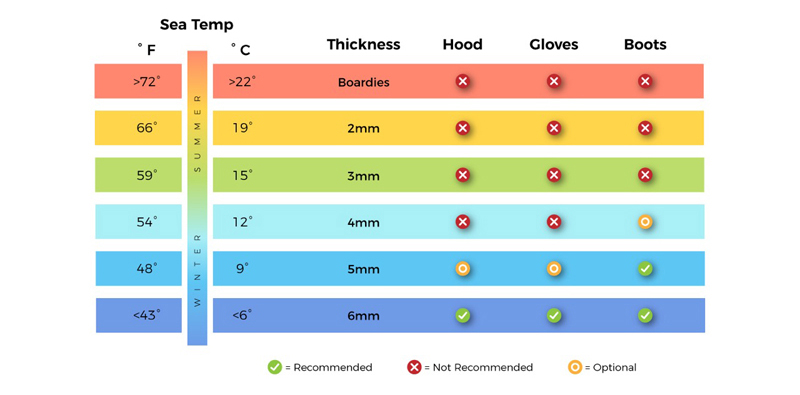
Seam Construction – This is one of the points where water is most likely to get in.
–Flat-Locked: The cheapest or thinnest summer suits, are often constructed with “flat-lock” stitching This is where the panels of the suit are joined with stitching that goes right through the neoprene – a bit like a piece of normal 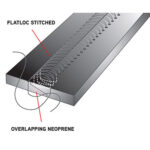 clothing. Anywhere with this type of stitching will tend to let a bit of water through.
clothing. Anywhere with this type of stitching will tend to let a bit of water through.
This isn’t really a big problem in a summer suit as all you really want is a bit of insulation to protect you from water a few degrees below body temperature. But you don’t want it when the water temperature is below about 12C.
-Glued and Blind-Stitched (GBS): The stitching is on the inside and only goes partly through the material. The outside half of the join is then glued to make a virtually water-tight seal.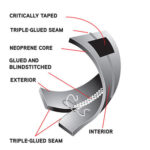
This is pretty effective at keeping water out and the best suits were all constructed this way until recently.
-Taped: Any suit apart from the most basic summer suit will usually have taped seams these days. A thin tape is glued over the inside of the seam to reinforce it and help to keep out any water that manages to get through the seam.
Not all suits have tape on all the seams. Sometimes it’s only on more crucial areas such as the torso and any high wear points.
– Fluid-Sealed: Suits that have blind stitched seams will sometimes be fluid sealed on the outside. You can see a line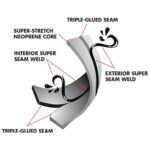 of rubber-like glue all the way down the outside of the seams.
of rubber-like glue all the way down the outside of the seams.
A number of manufacturers now use this method through the whole seam, eliminating the need for any stitching.
This makes for the most flexible and water-tight seams.
Smoothskin – Most neoprene is made up of a layer of rubber-like neoprene material with a very thin lining of fabric on both sides. This gives it greater resistance to snagging or tearing.

However, a downside of this is that the fabric tends to retain water and can cause a wind-chill effect, wicking heat away from the body on exposed areas.
Some wetsuits have panels, typically on the back and chest made of “raw” neoprene, which doesn’t have the fabric lining on the outside. This is known as “smoothskin” and the benefit is that the water runs off and reduces the wind-chill affect on those areas.
Entry System – This is simply how you get into the suit or, in other words, where the zip is.
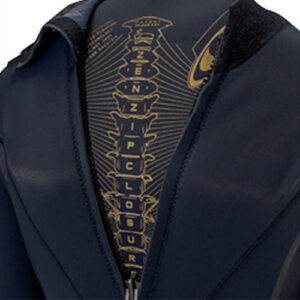
– Back Zip: The traditional place for a zip is down the back, and is usually easier to get in and out of than the other options.
– Front-Zip: As wetsuit neoprene has become more stretchy over the years, a big proportion of suits now have a front entry system, with a zip across the top of the chest. These can be a bit more difficult to get into, but generally feel more comfortable and flexible once you’re in. They also tend to be more water-tight.
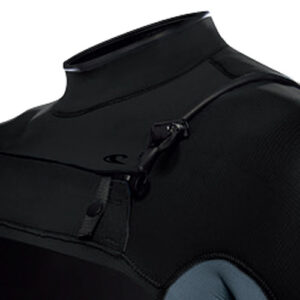
– Bat-Wing: This is usually found in suits with a back zip and is a sort of gusset inside the opening that stops any water that gets in from flushing down your back. There’s usually a collar that pulls over your head before you zip up, creating a water-tight seal. Not all back zip suits have this and it’s definitely worth looking for in a winter suit.
– Zipless Entry: A few suits are now available with no zip. Usually there is an opening at the front with a sort of batwing that pulls over your head. The front flap then ties down across the front. The idea is they give more comfort and flexibility.
The choice of entry system is really a matter of personal preference, although if you are larger in build or have some flexibility issues, then a back-zip suit will generally be easier to get in and out of.
The zipless suit is probably more beneficial to surfers than kitesurfers because they need more flexibility, and spend more time immersed in the water.
Flexibility/Stretch – There have been massive developments in neoprene material in recent years and the best suits now have so much stretch in them that they really feel like a second skin.
It also makes them a lot easier to get on and off – my first really warm winter suit was toasty warm but I’d get more exhausted trying to pull it on and off than I would actually kitesurfing!
Most suits will have the most stretchy neoprene on the arms and legs, where flexibility is most important.
The more expensive suits tend to have the most flexible material, but even fairly low budget ones now have plenty of stretch in them.
Steamer – You’ll still hear the term “steamer” used. Basically any one-piece suit is what it refers to. It’s because of the steam that allegedly comes out of a suit in cold weather, when you unzip it.
“Ballooning” – This is the weird phenomenon experienced by kitesurfers where water thrown up from the edge of the board finds it’s way into the legs of your wetsuit. It gets in through the bottom of the wetsuit legs and stays there, causing the wetsuit to “balloon” around your lower leg.
It’s really annoying and looks pretty uncool too! It’s a common joke on the beach – “Look who’s p***ed in his 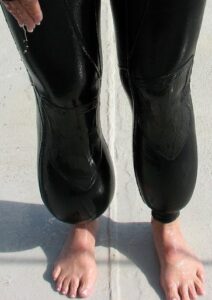 wetsuit!”.
wetsuit!”.
A good wetsuit will have tightening straps or seals at the ankles to help prevent this. But I’ve found a cheap and easy way to stop it is with a couple of strips of overlapping velcro wrapped around the ankles of a suit.
A few wetsuits even have one-way drain holes in the ankles to let any accumulated water out.
The other way to avoid it, if you’re wearing wetsuit boots, is to tuck the bottom of the wetsuit legs into the boots.
Thermal Lining – Most winter wetsuits have a fleecy lining in the inside of the upper torso, and in some cases the legs too. It’s amazing the difference this makes to the heat retention properties as it traps air, and any water that gets in and creates an insulating layer against the cold.
Shorty – A thin summer wetsuit with short legs and arms.
Wetsuit Sizing
It’s really important to get the right size and fit of westuit. I know that sounds obvious, but it’s not just a case of it being the right size. It has to be a snug fit with no bagging in areas like the back.
Any large gaps between you and the suit will accumulate water and reduce the effectiveness of the suit.
So it’s worth trying a suit on if you can. However, all westuit brands provide detailed size guides and they tend to be pretty accurate. So if you’re buying online you should be fine as long as there’s a return policy in case it doesn’t fit well.
Kitesurfing or Surfing Wetsuits?
Most wetsuit brands have their origins in surfing, and surfers still make up their main customer base. For that reason, there aren’t really any kitesurfing specific wetsuits on the market.
The other obvious wetsuit market is scuba-diving, and scuba wetsuits are generally not suitable for kitesurfing as they cater for completely different needs.
It’s worth bearing in mind though, when you’re trying to narrow down which wetsuit to buy, that kitesurfers generally don’t have exactly the same needs as surfers. And there are a few features in a suit that are more suited to surfers or kitesurfers,
Firstly, surfers tend to spend more time immersed in the water. So really good water-tightness is a bit more important to them.
So, whilst having cold water flushed down your back is never pleasant, it means that, if you’re on a budget you can get away without some of the water tightness properties of a more expensive suit, if you need to.
And kitesurfers don’t spend most of their time lying on a board and paddling. So upper torso flexibility isn’t as important to most kitesurfers, unless they’re into advanced freestyle tricks.
But wind-chill is a bigger factor for kitesurfers as we tend to be out of the water and exposed to the wind. So features such as smoothskin on the upper body are worth considering in a kitesurfing wetsuit.
Also, the most expensive wetsuits are extremely flexible and are really aimed at competition level surfers, with a lot of expensive features that really aren’t that important to kitesurfers. So that’s good news for us!
Boots, Gloves, Hoods and Other Bits.
The extremities such as hands, feet and face also need to be protected. But I tend to find I don’t need these additions until water or air temperature drops below about 12C. At that point you will definitely need boots and gloves, and much below that you’ll also need some kind of head and face protection.
A number of winter wetsuits have the option of a hooded version, which is great, although probably more important for surfers than kitesurfers.
I use a neoprene beanie hat, rather than a hood, on all but the coldest days of winter, and it works pretty well.
Boots and gloves are quite an area of discussion amongst kitesurfers. I personally like the thinnest I can get away with, as I like to feel connected to the board and bar. But there some great options out there and I’ll be covering the best of these in separate articles.
Another way of upgrading a suit for the coldest days is to use a neoprene hoody, which is pretty much as it sounds and can be worn over your wetsuit.
Price-range
Firstly, if the water/wind temperature is warm enough to wear a thin summer suit such as a 3/2mm, then it’s probably not worth spending a lot of money on that suit. You’ll get everything you need for less than £100 ($130).
If you are likely to kitesurf in water temperatures of less than about 12C then you’ll need a suit of at least 4/3mm.
I personally have a 3/2mm and a 5/4mm and this combination sees me right through the year without the need for a third suit. I also have a shorty which I use in warmer climates occasionally in the winter, mainly if the air temperature is a bit cooler.
If you’re likely to kite in water temperatures less than about 12C and right down to freezing, it’s worth spending more money on a decent 5/3 or 5/4mm suit as it will see you right through the colder season. And in terms of price you should budget to spend from £150 ($195) to £360 ($470).
At the lower end of the price range you’ll be compromising on durability and overall warmth and flexibility. At the top end of the price range you should expect the suit to last 5 or 6 years, depending on care and amount of use, so it’s a good investment, if you can afford it.
I don’t tend to wear boots until the water temperature is below about 10C and hood and gloves below about 6C, but it’s all down to how much you feel the cold.
A good pair of boots will be £30 upwards and hoods and gloves about £20 and upwards.
Conclusion
There’s a huge range of wetsuits available now, and I’ve written a separate article on the suits I believe offer the best value for money. Check it out here.
But if you’d like an advance preview of these, press the “follow” button or leave a comment below and I’ll get back to you with my advice.

